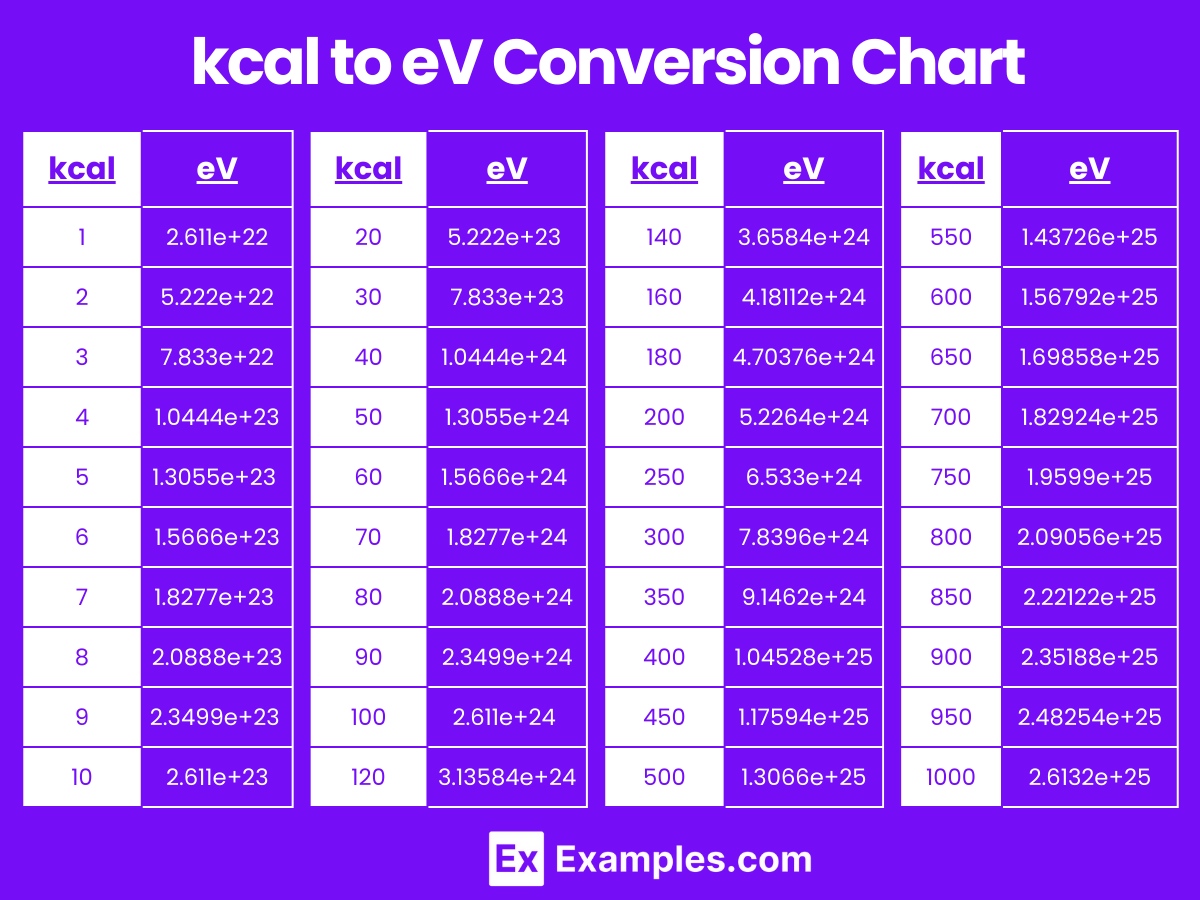Achieve fast and accurate conversions between Kilocalories and Electronvolts with examples.com. Our intuitive tools make energy unit conversions effortless!
kcal to eV
Formula: Energy in Electronvolts (eV) = Energy in Kilocalories (kcal) x 2.611e+22
Kilocalorie :
Electronvolt :
| Kilocalories | Electronvolts |
|---|---|
| 1 | 2.611e+22 |
eV to kcal
Formula: Energy in Kilocalories (kcal) = Energy in Electronvolts (eV) ÷ 2.611e+22
Electronvolt :
Kilocalorie :
| Electronvolts | Kilocalories |
|---|---|
| 1 | 3.8299502106472615e-23 |
Energy Converters to Kilocalorie
Energy Converters to Electronvolt
Conversion Factors:
- Kilocalories to Electronvolts: 1 kilocalorie=2.611×1022 electronvolts
- Electronvolts to Kilocalories: 1 electronvolt=1/2.611×1022 kilocalories
How to Convert Kilocalories to Electronvolts:
To convert kilocalories to electronvolts, multiply the number of kilocalories by 2.611×1022
Electronvolts=Kilocalories×2.611×1022
Example: Convert 3 kilocalories to electronvolts.
Electronvolts=3×2.611×1022=7.833×1022 electronvolts
How to Convert Electronvolts to Kilocalories:
To convert electronvolts to kilocalories, divide the number of electronvolts by 2.611×1022
Kilocalories=Electronvolts/2.611×1022
Example: Convert 5.222×1022 electronvolts to kilocalories.
Kilocalories=5.222×1022/2.611×1022=2 kilocalories
Kilocalories to Electronvolts Conversion Table
| Kilocalories (kcal) | Electronvolts (eV) |
|---|---|
| 1 kcal | 2.611e+22 eV |
| 2 kcal | 5.222e+22 eV |
| 3 kcal | 7.833e+22 eV |
| 4 kcal | 1.0444e+23 eV |
| 5 kcal | 1.3055e+23 eV |
| 6 kcal | 1.5666e+23 eV |
| 7 kcal | 1.8277e+23 eV |
| 8 kcal | 2.0888e+23 eV |
| 9 kcal | 2.3499e+23 eV |
| 10 kcal | 2.611e+23 eV |
| 20 kcal | 5.222e+23 eV |
| 30 kcal | 7.833e+23 eV |
| 40 kcal | 1.0444e+24 eV |
| 50 kcal | 1.3055e+24 eV |
| 60 kcal | 1.5666e+24 eV |
| 70 kcal | 1.8277e+24 eV |
| 80 kcal | 2.0888e+24 eV |
| 90 kcal | 2.3499e+24 eV |
| 100 kcal | 2.611e+24 eV |
kcal to eV Conversion Chart

Electronvolts to Kilocalories Conversion Table
| Electronvolts (eV) | Kilocalories (kcal) |
|---|---|
| 1 eV | 3.829e-23 kcal |
| 2 eV | 7.658e-23 kcal |
| 3 eV | 1.1487e-22 kcal |
| 4 eV | 1.5316e-22 kcal |
| 5 eV | 1.9145e-22 kcal |
| 6 eV | 2.2974e-22 kcal |
| 7 eV | 2.6803e-22 kcal |
| 8 eV | 3.0632e-22 kcal |
| 9 eV | 3.4461e-22 kcal |
| 10 eV | 3.829e-22 kcal |
| 20 eV | 7.658e-22 kcal |
| 30 eV | 1.1487e-21 kcal |
| 40 eV | 1.5316e-21 kcal |
| 50 eV | 1.9145e-21 kcal |
| 60 eV | 2.2974e-21 kcal |
| 70 eV | 2.6803e-21 kcal |
| 80 eV | 3.0632e-21 kcal |
| 90 eV | 3.4461e-21 kcal |
| 100 eV | 3.829e-21 kcal |

Difference Between Kilocalories to Electronvolts
| Aspect | Kilocalories (kcal) | Electronvolts (eV) |
|---|---|---|
| Definition | A unit of energy commonly used in nutrition and food science. | A unit of energy used in atomic and particle physics. |
| Conversion Factor | 1 kcal = 2.611e+22 eV | 1 eV = 3.829e-23 kcal |
| Typical Usage | Measuring the energy content of food. | Measuring the energy of particles at the atomic scale. |
| Scale | Macro level, suitable for human consumption measurements. | Micro level, suitable for atomic and subatomic measurements. |
| Symbol | kcal | eV |
| Context of Use | Commonly used in dietary and nutritional contexts. | Commonly used in physics, especially in quantum mechanics and particle physics. |
| Magnitude | Larger unit of energy suitable for everyday life. | Smaller unit of energy used for very small-scale phenomena. |
| Scientific Relevance | Important in biochemistry and health sciences. | Crucial in understanding atomic structure and reactions. |
1. Solved Examples on Converting Kilocalories to Electronvolts
Example 1:
Problem: Convert 1 kilocalorie to electronvolts.
Solution: Electronvolts=1×2.611×1022
Electronvolts=2.611×1022
Example 2:
Problem: Convert 5 kilocalories to electronvolts.
Solution: Electronvolts=5×2.611×1022
Electronvolts=1.3055×1023
Example 3:
Problem: Convert 10 kilocalories to electronvolts.
Solution: Electronvolts=10×2.611×1022
Electronvolts=2.611×1023
Example 4:
Problem: Convert 0.5 kilocalories to electronvolts.
Solution: Electronvolts=0.5×2.611×1022
Electronvolts=1.3055×1022
Example 5:
Problem: Convert 25 kilocalories to electronvolts.
Solution: Electronvolts=25×2.611×1022
Electronvolts=6.5275×1023
2. Solved Examples on Converting Electronvolts to Kilocalories
Example 1:
Problem: Convert 5.222×1022 electronvolts to kilocalories.
Solution: Kilocalories=5.222×1022/2.611×1022
Kilocalories=5.22/22.611
Kilocalories=2
Example 2:
Problem: Convert 1.3055×1023 electronvolts to kilocalories.
Solution: Kilocalories=1.3055×1023
Kilocalories=1.3055/2.611= 5Kilocalories=5
Example 3:
Problem: Convert 2.611×1023electronvolts to kilocalories.
Solution: Kilocalories=2.611×1023/2.611×1022
Kilocalories=2.611/2.611
Kilocalories=10
Example 4:
Problem: Convert 1.3055×1022 electronvolts to kilocalories.
Solution: Kilocalories=1.3055×1022/2.611×1022
Kilocalories=1.3055/2.611
Kilocalories=0.5
Example 5:
Problem: Convert 6.5275×1023 electronvolts to kilocalories.
Solution: Kilocalories=6.5275×1023/2.611×1022
Kilocalories=6.5275/2.611
Kilocalories=25
How accurate is the conversion between Kilocalories and Electronvolts?
The conversion is very accurate and is based on the established relationship between the joule, kilocalorie, and electronvolt. 1 kcal = 4184 joules, and 1 joule = 6.242 × 10^18 eV.
Are there any tools or calculators available for this conversion?
Yes, there are many online converters and calculators available that can perform the conversion between kilocalories and electronvolts with ease.
Why would someone need to convert Kilocalories to Electronvolts?
This conversion might be necessary in scientific research where understanding energy in different units is crucial, such as in biophysics, biochemistry, or when bridging concepts between nutrition and particle physics.
Is Kilocalories to Electronvolts a common conversion?
While not commonly encountered in everyday scenarios, this conversion is significant in specialized scientific fields where different units of energy measurement are used.
Are there common applications of kilocalories in everyday life?
Yes, kilocalories are commonly used to describe the energy content of food and beverages, helping individuals manage their diet and energy intake for weight management and overall health.

